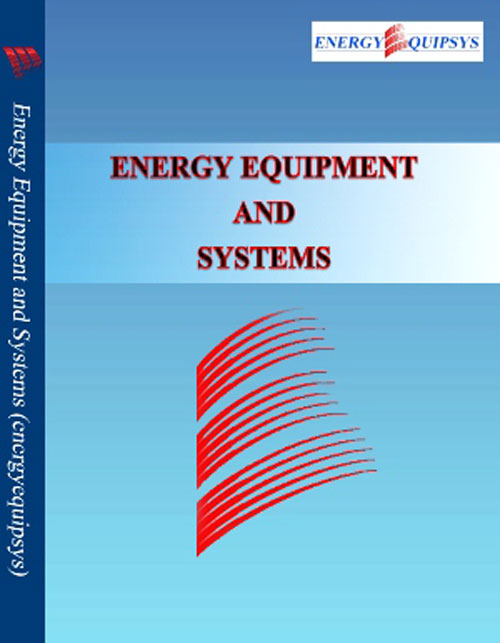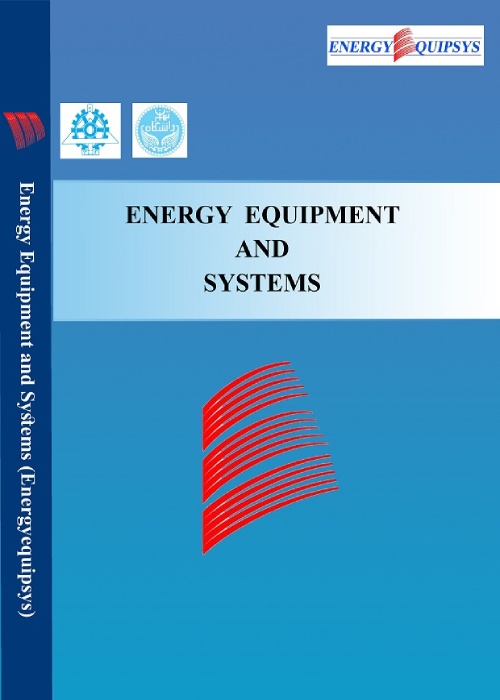فهرست مطالب

Energy Equipment and Systems
Volume:4 Issue: 1, Spring and Summer 2016
- تاریخ انتشار: 1395/03/31
- تعداد عناوین: 7
-
-
Pages 1-10The purpose of this study is to improve the aerodynamic performance of wind turbine blades, using the Ball-Spine inverse design method. The inverse design goal is to calculate a geometry corresponds to a given pressure distribution on its boundaries. By calculating the difference between the current and target pressure distributions, geometric boundaries are modified so that the pressure difference becomes negligible and the target geometry can be obtained. In this paper, The Ball-Spine inverse design algorithm as a shape modification algorithm is incorporated into CFX flow solver to optimize a wind turbine airfoil. First, the presented inverse design method is validated for a symmetric airfoil in viscous incompressible external flows. Then, the pressure distribution of the asymmetric airfoil of a horizontal wind turbine is modified in such a way that its loading coefficient increases. The lift coefficient and lift to drag ratio for the new modified airfoil get 5% and 3.8% larger than that of the original airfoil. The improved airfoil is substituted by the original airfoil, respectively. in the wind turbine. Finally, the aerodynamic performance of the new wind turbine is calculated by 3-D numerical simulation. The results show that the power factor of the new optimized wind turbine is about 3.2% larger than that of the original one.Keywords: ANSYS CFX, Improved Aerodynamics, Inverse Design, Wind Turbine Airfoil
-
Pages 11-19An efficient procedure is presented for the evaluation of solid oxide fuel cell (SOFC) anode microstructure triple phase boundary length (TPBL). Triple phase boundary- the one that is common between three phases of the microstructure- has a great influence on the overall efficiency of SOFC because all electrochemical reactions of anode take place in its vicinity. Therefore, evaluation of TPBL for virtual or experimental 3D microstructures is essential for comparison purposes and the optimization processes. In this study, first, an algorithm is proposed to distinguish between percolated and non-percolated clusters for each of the phases. Then, another algorithm is used to determine the value of TPBL for all percolated clusters of three phases. Also, a procedure based on thermal and diffusion analogy is presented to assess the tortuosity of porous and solid phases. Finally for a virtual microstructure, percolated clusters, active and total TPBL and tortuosity are calculated and discussed.Keywords: Active Triple Phase Boundary Length, Anode, Active Cluster, Solid Oxide Fuel Cell, Tortuosity
-
Pages 21-30Considering that the effective yield of a panel is equal to its total number of hours of solar radiation and temperature, only the effects of temperature and solar radiation intensity at the maximum power point (MPP) are investigated in this article. By collecting temperature data, sun's radiation hours from six synoptic meteorological stations in Kermanshah Province over the course of an eleven-year period (1995-2005), with the use of GIS software, a map of Kermanshah Province's temperature and radiation based on plotted latitude and longitude as well as the establishment of regression, the most suitable location for solar panels is proposed. In this MATLAB software simulation using the characteristics of panel MSX-64, all parameters have been considered and determined by the characteristics of the panel. Throughout the process, the design has been based on four parameters as the primary specifications of the solar panels: Isc, Voc, Imp, Vmp. With the ability to simulate other solar panels with temperatures and radiation intensity corresponding to each area, the I-V curve of each custom solar panel can be drawn, making it possible to obtain the maximum power.Keywords: GIS, Interpolation, MATLAB, Regression, Solar panel Msx, 64
-
Pages 31-41Plate heat exchangers are widely used in industries due to their special characteristics, such as high thermal efficiency, small size, light weight, easy installation, maintenance, and cleaning. The purpose of this study is to consider the effect of depth, angle, and pitch of hemispheric Chevrons on the convective heat transfer coefficient and pressure drop. In the simulation of the heat exchanger, water and stainless steel are chosen for fluid and plate materials, respectively. The process is considered to be steady state, single-phase, and turbulent. In brief results show that the convective heat transfer coefficient and pressure drop decrease where the Chevrons depth and pitch increase. Moreover, these parameters enhance increment of the Chevrons angle up to 90°, after which they decrease with the Chevron angle. lastly, results are compared with Kumar equation which has been presented for corrugated plates. Maximum relative difference in this comparison is approximately 30%. As a result, a new correlation is proposed for the convective heat transfer coefficient in terms of the Reynolds number and the plate geometry.Keywords: Chevron Angle, Chevron Depth, Chevron Pitch, Numerical Analysis, Plate Heat Exchanger
-
Pages 43-52The purpose of this research is to investigate thermoeconomic optimization and exergy analysis of transcritical CO2 refrigeration cycle with an ejector. After modeling thermodynamic equations of elements and considering optimization parameters of emerging temperature of gas of cooler (Tgc) , emerging pressure of cooler's gas (Pgc) , and evaporative temperature (Tevp) , optimization of target function is done. Target function indicates total expenses of the system during a year which is consisted of expenses of entering exergy and spending on the system's equipment. Optimized amplitude of decision variables are gained by the balance between the entering exergy and yearly initial capital investing. Results indicate reduction in yearly total expenses of system (34%) and enhancement in thermodynamic functionality coefficient and exergetic efficiency in optimum point toward end point.Keywords: Exergy, Refrigeration, Thermoeconomic, Transcritical CO2
-
Pages 53-64Cement production is an energy-intensive process, so that the cement industry occupies a top position among other energy-consuming industries. Among the equipment used in cement industries, boilers are one of the energy-consuming equipment. Boilers are among the common heating equipment in industrial, commercial, and institutional facilities. In this paper, the performance of thermal oil boiler and useful methods in improving its efficiency and saving energy was investigated. Under normal condition, results showed that the boiler was only working with 55% of its capacity, and in this case, boiler efficiency was 77.48%, based on the heat loss method. Moreover, optimization of excess air level in combustion process as one of the improving performance methods increased the boiler efficiency by about 3%. The volume of fuel was also reduced to about 34.07 m3/HR, using economizer as another method.Keywords: Boiler Efficiency, Economizer, Excess Air, Thermal Oil Boiler
-
Pages 65-79Using the FACTS controllers, such as static synchronous compensator (STATCOM), as it provides continuous reactive power, in the grid including wind turbine (WT) equipped with doubly fed induction generator, for improving voltage profile (under normal circumstances) and providing a transition ability from inductor generator transition state has been proposed. In this paper, in order to control the controllers and explained goals, nonlinear controller, as a substitute for the traditional controller, is presented. Replacing STATCOM controller in wind farm, which is equipped with doubly fed induction generator (DFIG) using input-output feedback linearization controller, the needed reactive power in order to stable wind farm equipped with DFIG is considered when error is occurred. The proposed control method has been simulated for IEEE-9 Bus, bus No 5, and the achievability to the desired targets in STATCOM efficiency for its reactive power has been investigated. The reasons of using these controllers in bus 5 are voltage dropping and reducing reactive power in this bus. It can be seen by compensating for voltage and reactive power in this bus that these two parameters have improved in other buses. The results show that with the proposed controller, STATCOM has done its duty well and the network bus voltage and reactive power to sustain the wind farm equipped with DFIG in transient mode is provided.Keywords: Doubly Fed Induction Generator, Static Synchronous Compensator, Transition State, Wind Farm, Input, Output Feedback Linearization Controller


